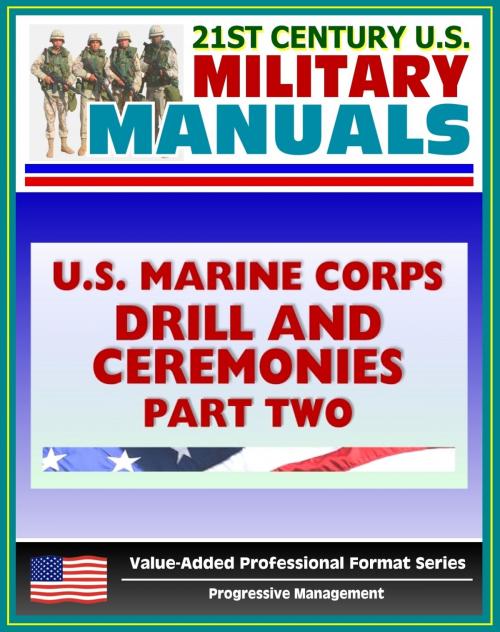21st Century U.S. Military Manuals: U.S. Marine Corps (USMC) Drill and Ceremonies Manual - Part Two, Parades, Funerals, Memorial Services, Customs and Courtesies, Mess Night Traditions
Nonfiction, History, Military, Naval, Social & Cultural Studies, Political Science| Author: | Progressive Management | ISBN: | 9781466129085 |
| Publisher: | Progressive Management | Publication: | February 13, 2012 |
| Imprint: | Smashwords Edition | Language: | English |
| Author: | Progressive Management |
| ISBN: | 9781466129085 |
| Publisher: | Progressive Management |
| Publication: | February 13, 2012 |
| Imprint: | Smashwords Edition |
| Language: | English |
Part of our value-added professional format series of U.S. military manuals, this U.S. Marine Corps manual covers drill and ceremonies.
This volume, part two of two, covers parades, battalion and regimental formations, presentation of decorations and individual retirement, change of command ceremony, activation and deactivation ceremony, honors, birthday cake cutting ceremony, funerals and memorial services, ceremonial property, history, customs and courtesies, and traditions of the mess night.
One of the cornerstones of Marine Corps customs, courtesies and traditions is our execution of close order drill and ceremonies. These traditions are perpetuated from one generation to the next through constant use and practice. The "esprit de corps" of every Marine has been brought about by their ever-present feeling of pride, not only in their unit, but also in themselves. The preservation of traditional discipline, our customs and courtesies, and the heritage of our Corps is our duty. It is our further duty to see that the same high standard of discipline and esprit de corps is not only preserved, but also further strengthened. These intangibles must be passed on to the future Marines who will take their place among the ranks our Corps.
The object of close order drill is to teach Marines by exercise to obey orders and to do so immediately in the correct way. Close order drill is one foundation of discipline and esprit de corps. Additionally, it is still one of the finest methods for developing confidence and troop leading abilities in our subordinate leaders.
Ceremonial duties are written deep into our history as a Corps. It is no coincidence that among the units famous for ceremonial prowess and spit-and-polish are also to be found some of the world's most redoubtable fighting formations. The hallmark of the world's fighting organizations, the Roman legions, the Spartans, the Foreign Legion, the British Brigade of Guards and many others is that they are as good on parade as they are in the field or in the attack. While we no longer use drill and formations to align the ranks as was done for the phalanxes of Rome or the squares of Waterloo, drill and ceremony is still the foundation of instilling and developing discipline in any size unit and the individual.
As a bonus, this reproduction includes the Marine Corps Manual, the basic publication of the United States Marine Corps issued by the Commandant of the Marine Corps and approved by the Secretary of the Navy - sold separately for $7.99. It is a regulatory publication for the Department of the Navy as defined in U.S. Navy Regulations. The Marine Corps Manual is designed primarily for use by Marine Corps commanders and their staffs, Navy officers exercising command over Marines, the staff of the Commandant of the Marine Corps, and the staffs of the bureaus and offices of the Navy Department. Contents: Chapter 1 - General Administration And Management * Chapter 2 - Manpower * Chapter 3 - Operations And Readiness * Chapter 4 - Logistics
Part of our value-added professional format series of U.S. military manuals, this U.S. Marine Corps manual covers drill and ceremonies.
This volume, part two of two, covers parades, battalion and regimental formations, presentation of decorations and individual retirement, change of command ceremony, activation and deactivation ceremony, honors, birthday cake cutting ceremony, funerals and memorial services, ceremonial property, history, customs and courtesies, and traditions of the mess night.
One of the cornerstones of Marine Corps customs, courtesies and traditions is our execution of close order drill and ceremonies. These traditions are perpetuated from one generation to the next through constant use and practice. The "esprit de corps" of every Marine has been brought about by their ever-present feeling of pride, not only in their unit, but also in themselves. The preservation of traditional discipline, our customs and courtesies, and the heritage of our Corps is our duty. It is our further duty to see that the same high standard of discipline and esprit de corps is not only preserved, but also further strengthened. These intangibles must be passed on to the future Marines who will take their place among the ranks our Corps.
The object of close order drill is to teach Marines by exercise to obey orders and to do so immediately in the correct way. Close order drill is one foundation of discipline and esprit de corps. Additionally, it is still one of the finest methods for developing confidence and troop leading abilities in our subordinate leaders.
Ceremonial duties are written deep into our history as a Corps. It is no coincidence that among the units famous for ceremonial prowess and spit-and-polish are also to be found some of the world's most redoubtable fighting formations. The hallmark of the world's fighting organizations, the Roman legions, the Spartans, the Foreign Legion, the British Brigade of Guards and many others is that they are as good on parade as they are in the field or in the attack. While we no longer use drill and formations to align the ranks as was done for the phalanxes of Rome or the squares of Waterloo, drill and ceremony is still the foundation of instilling and developing discipline in any size unit and the individual.
As a bonus, this reproduction includes the Marine Corps Manual, the basic publication of the United States Marine Corps issued by the Commandant of the Marine Corps and approved by the Secretary of the Navy - sold separately for $7.99. It is a regulatory publication for the Department of the Navy as defined in U.S. Navy Regulations. The Marine Corps Manual is designed primarily for use by Marine Corps commanders and their staffs, Navy officers exercising command over Marines, the staff of the Commandant of the Marine Corps, and the staffs of the bureaus and offices of the Navy Department. Contents: Chapter 1 - General Administration And Management * Chapter 2 - Manpower * Chapter 3 - Operations And Readiness * Chapter 4 - Logistics















